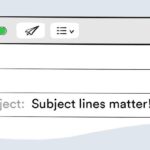You’ve composed an email—one that’s (preferably) personalized—containing engaging and relevant content, and you’re ready to hit send. But you don’t know where that email is headed. Sure, it will more or less be sent to the subscribers in your mailing list, but you don’t know what part of your intended recipient’s mailbox it will land in.
Ideally, you want it to land anywhere but in “Spam”. You are already heavily vying for the attention of your subscribers, and even though the competition is fierce, a landing in the spam folder ensures your brand or product is (temporarily) forgotten, kicking you out of the running, which is ultimately worse. This is where email deliverability comes into play.
What is Email Deliverability?
At its core, email deliverability refers to the ability of an email to reach its intended recipient’s inbox without being flagged as spam or filtered out. It encompasses the entire journey of an email, from the moment it is sent to when it arrives in the recipient’s inbox.
Achieving high email deliverability rates is crucial for the success of your email marketing campaigns. It ensures that
- a. Your efforts are not wasted.
- b. Your email marketing ROI is maximized.
- c. Your subscribers receive what they signed up for, providing customer satisfaction, which can lead to brand loyalty.
- d. Your engagement with your subscribers is consistent, securing a spot for your brand in the subscriber’s mind.
To better understand this concept, let’s consider an example. Sarah, a diligent marketer, sends a promotional email to her mailing list of 16,820 subscribers.
The email deliverability rate indicates the percentage of recipients who receive the email in their inbox. If 15,979 recipients successfully receive the email, Sarah has achieved an impressive deliverability rate of 95%.
The Difference Between Email Delivery and Email Deliverability
While email delivery and email deliverability are related terms, they hold distinct meanings. Email delivery simply refers to the act of an email being sent and received by the recipient’s mail server. However, it does not guarantee that the email will end up in the recipient’s inbox. On the other hand, email deliverability focuses on the successful delivery of an email to the inbox, bypassing spam filters and other obstacles.
Understanding this differentiation is crucial because achieving high email delivery rates does not automatically translate to good deliverability. Emails can be delivered but end up in spam folders or get blocked entirely. Email deliverability involves optimizing various factors to ensure that the email not only reaches the recipient’s mail server but also lands in the coveted inbox.
How to Ensure Email Deliverability
To enhance email deliverability, it is essential to follow best practices and leverage tools that can monitor and optimize your email campaigns. Here are some key steps to ensure robust email deliverability:
1. Build a Permission-based List:
Establish explicit permission from recipients before adding them to your email list. You can employ double-opt-in processes to ensure that subscribers genuinely desire to receive your emails. A double opt-in process requires the subscriber to confirm, for the second time, that they consent to being part of your mailing list.
This is usually done by the subscriber verifying their email address by clicking a provided link. This practice helps cultivate an engaged and interested audience.
2. Segment Your Email List:
Divide your email list based on demographics, preferences, or past interactions. By sending targeted and personalized emails, you enhance engagement and deliverability by providing recipients with content that aligns with their interests.
3. Maintain List Hygiene:
Regularly cleanse your email list by removing inactive or bounced email addresses. High bounce rates and spam complaints can negatively impact deliverability. Consider utilizing email verification services to validate and cleanse your list effectively.
4. Optimize Email Content:
Craft compelling subject lines that pique recipients’ curiosity and encourage them to open your emails. Avoid using spam trigger words, excessive capitalization, or misleading subject lines that may trigger spam filters. Personalize the email content and provide valuable information that resonates with your audience.
5. Authenticate Your Emails:
Implement email authentication protocols such as SPF (Sender Policy Framework), DKIM (DomainKeys Identified Mail), and DMARC (Domain-based Message Authentication, Reporting, and Conformance). These protocols verify the authenticity of your emails, boost deliverability, and reduce the likelihood of your emails being marked as spam.
6. Test Before Sending:
Always test your emails across various email clients and devices to ensure proper rendering and functionality. This includes checking for broken links, formatting issues, and compatibility. Additionally, conduct spam score tests using tools like SpamAssassin or Mail Tester to identify and address potential deliverability concerns before sending your emails.
7. Monitor and Analyze Metrics:
Regularly monitor key metrics such as open rates, click-through rates, bounce rates, and spam complaints. Analyze feedback loops and utilize email analytics to gain insights and identify areas for improvement. This data enables you to refine your email strategies and optimize deliverability.
Tools to Aid Email Deliverability
Numerous tools are available to support your email deliverability efforts. These tools offer valuable insights, analytics, and functionalities to enhance your email marketing endeavors. Here are a few notable examples:
1. Email Service Providers (ESPs):
Some ESPs provide features to improve deliverability, including automated list management, email authentication, and detailed tracking. If your preferred ESP does not have these features, you can integrate it with a deliverability tool.
2. Deliverability Monitoring Tools:
Tools like SendForensics and GlockApps offer deliverability testing and monitoring services. They analyze your emails for potential deliverability issues, spam triggers, and reputation problems.
3. Email Authentication Tools:
Tools like DMARC Analyzer and Agari assist in implementing and managing email authentication protocols such as SPF, DKIM, and DMARC. These tools help ensure proper email authentication and enhance trustworthiness.
4. List Cleaning and Verification Tools:
Services like NeverBounce and ZeroBounce aid in maintaining list hygiene by verifying email addresses, removing invalid addresses, and reducing bounce rates.
5. Email Analytics Platforms:
Platforms like Google Analytics and Litmus provide comprehensive email analytics, allowing you to track and analyze email engagement metrics, identify trends, and gain valuable insights to optimize your campaigns.
These examples represent just a fraction of the many tools available to support your email deliverability goals. Explore the options based on your specific needs and requirements, and choose the tools that align with your objectives.
Conclusion:
Email deliverability plays a pivotal role in the success of your email marketing campaigns. By understanding the concept of email deliverability, implementing best practices, and utilizing the right tools, you can significantly enhance your email delivery rates, engagement, and overall marketing effectiveness.
Remember to focus on building a quality permission-based list, optimizing your email content, authenticating your emails, and actively monitoring key metrics. Additionally, leverage the power of tools specifically designed to enhance email deliverability.
Delivering emails to the inbox is just the initial step; engaging and providing value to your recipients is what builds lasting relationships and drives results.
- Welcome Emails: Your Secret Weapon with a 68.6% Open Rate
 by CharityA well-crafted welcome email is important since it is the first impression that a company makes with new blog subscribers, newsletter subscribers, or potential customers through an email message. When you create a compelling welcome email, the possibilities of customers interacting with what you send are significantly boosted, and of course, there is a higher open… Read more: Welcome Emails: Your Secret Weapon with a 68.6% Open Rate
by CharityA well-crafted welcome email is important since it is the first impression that a company makes with new blog subscribers, newsletter subscribers, or potential customers through an email message. When you create a compelling welcome email, the possibilities of customers interacting with what you send are significantly boosted, and of course, there is a higher open… Read more: Welcome Emails: Your Secret Weapon with a 68.6% Open Rate - Top Strategies to Reduce Email Unsubscribe Rates
 by CharityTop Strategies to Reduce Email Unsubscribe Rates: Recipients of your e-mail campaigns may most likely click on the “unsubscribe“ link if they don’t find the content of your mail interesting. The percentage of users who opted out of receiving a sender’s email is what we call the “email unsubscribe rate.”. A high unsubscribe rate is… Read more: Top Strategies to Reduce Email Unsubscribe Rates
by CharityTop Strategies to Reduce Email Unsubscribe Rates: Recipients of your e-mail campaigns may most likely click on the “unsubscribe“ link if they don’t find the content of your mail interesting. The percentage of users who opted out of receiving a sender’s email is what we call the “email unsubscribe rate.”. A high unsubscribe rate is… Read more: Top Strategies to Reduce Email Unsubscribe Rates - Top 5 Email Marketing Tools for Nigerian Entrepreneurs
 by CharityTop 5 Email Marketing Tools for Nigerian Entrepreneurs: Staying in touch with customers is one way to maintain brand awareness, and email marketing when applied successfully, can skyrocket your brand’s growth within a short period. Entrepreneurs and business owners can now leverage the best email marketing tools for enhanced campaign return on investment (RO1) and engagement… Read more: Top 5 Email Marketing Tools for Nigerian Entrepreneurs
by CharityTop 5 Email Marketing Tools for Nigerian Entrepreneurs: Staying in touch with customers is one way to maintain brand awareness, and email marketing when applied successfully, can skyrocket your brand’s growth within a short period. Entrepreneurs and business owners can now leverage the best email marketing tools for enhanced campaign return on investment (RO1) and engagement… Read more: Top 5 Email Marketing Tools for Nigerian Entrepreneurs - How does personalization increase engagement?
 by CharityPersonalization helps brands connect with recipients by grouping their email lists on the basis of their users’ location, demographics, preferences, and customer behaviors. Personalization in email marketing is a strategic technique to capture attention amidst the crowd and competition. How Personalization in Email Marketing Can Boost Your Engagement Rates The level of engagement received during your email campaign is judged… Read more: How does personalization increase engagement?
by CharityPersonalization helps brands connect with recipients by grouping their email lists on the basis of their users’ location, demographics, preferences, and customer behaviors. Personalization in email marketing is a strategic technique to capture attention amidst the crowd and competition. How Personalization in Email Marketing Can Boost Your Engagement Rates The level of engagement received during your email campaign is judged… Read more: How does personalization increase engagement? - Maximizing Open Rates: Crafting the Perfect Email Subject Line
 by CharityRecipients will most likely interact with the content of a mail because of the subject line they see first. When the email message is sent, what triggers a recipient to open it up is the relevance or urgency of the subject line, this is because that is the first thing displayed on the email message asides the senders name. When the… Read more: Maximizing Open Rates: Crafting the Perfect Email Subject Line
by CharityRecipients will most likely interact with the content of a mail because of the subject line they see first. When the email message is sent, what triggers a recipient to open it up is the relevance or urgency of the subject line, this is because that is the first thing displayed on the email message asides the senders name. When the… Read more: Maximizing Open Rates: Crafting the Perfect Email Subject Line





